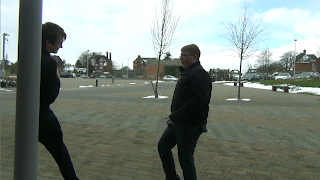The preliminary task helped me learn a lot about creating a media product in a group, including aspects of teamwork, hardware operation, software operation and directing. This knowledge then helped us in the creation of our final media product - the opening scene to a techno-thriller film.
For both the creation of the preliminary task and the final product, we worked in a team. However, the team during the preliminary task was much larger than the final team we worked with - infact, the team size decreased from four members to just two. We also organized the way the team worked better, including assigning each member of a team a different role in the design and creation of the film, as this is something that we didn't do in the preliminary task. This made working together much easier, as we all knew what we needed to do.
 |
| This shot made use of different editing techniques which were learnt from the preliminary task |
We also learnt a lot about the hardware we needed to use. While filming the preliminary task, we did not use a tripod. This made things harder to film, as someone needed to be constantly holding the camera. With the tripod, it made footage a lot smoother, as well as making filming easier to record.
Different editing and filming techniques were also made possible with the introduction of the tripod, as it allowed us to record multiple clips from the same angle. This allowed us to do things such as taking a video of an empty scene and cropping it over the shot of another scene. We used this to do the special effect where Scherbius appeared from behind a pillar.
Overall, I have learnt a lot through the creation of the preliminary task which was then carried forward to make the final production. This has not only improved the overall quality of our final production, but helped me to improve my knowledge and skills of creating a media product.






